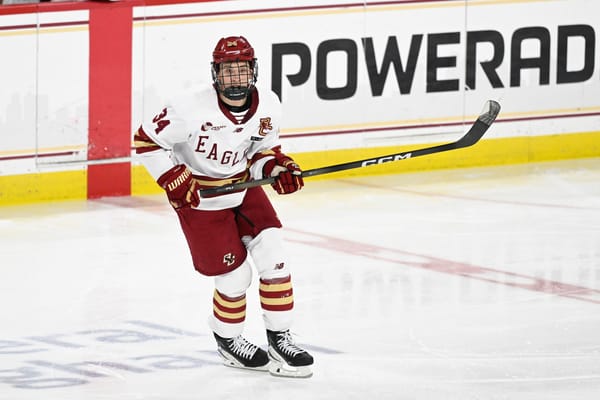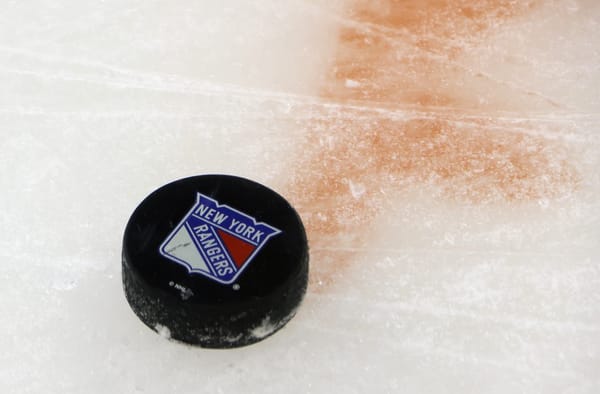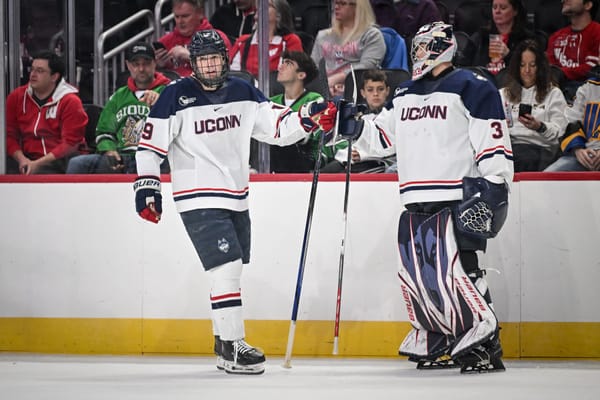Alleviating Andersson: Upcoming Season Could Provide New Lias on Life for Rangers’ Center
There’s still time to right the young Swede’s career, but the clock is ticking
The Rangers busy offseason thus far — now dubbed a build, rather than a rebuild — has raised expectations across the board. With Kaapo Kakko & Co. in tow, not only is the team a possible Wild Card player, but many young players are going to be relied upon to step in and begin contributing toward that goal out of the gate.
For Lias Andersson, however, that influx in talent could actually award him a safety net of sorts by lowering expectations that were too highly placed on him to begin with.
Let’s make no bones about it — the Rangers made a mistake in hyping the then 18-year-old, harping on his apparent “NHL-readiness” following his seventh overall selection at the 2017 draft, which the Rangers obtained in the deal that sent Derek Stepan west to Arizona. In doing so, the team placed unattainable expectations on a player who was too young and clearly not ready to carry that load.
There’s no putting that toothpaste back in the tube, but luckily for the Rangers, the 2017 draft hasn’t actually produced much to be envious of following Andersson’s pick, which mitigates the criticism the franchise has been hit with following each of Andersson’s failed shots at making the team full-time thus far.
Now two years later, thanks to the waves made by the Artemi Panarin signing, the Jacob Trouba trade, and the likely injection of both Kakko and 2018’s ninth overall pick Vitali Kravtsov to an improved forward corps, the pressure that remained on Andersson’s shoulders has been alleviated. At least for now.
Among the positives for Andersson is an entire summer to go before training camp with only a handful of certainties ahead of 2019-20. Mika Zibanejad will anchor the first line center position, but what do the Rangers envision behind him?
Will Filip Chytil, who was drafted as a center but was forced into a role on the wing for much of last season, find his way back to the middle? It’s probably in the Rangers’ best interests to try his hand there again, potentially as high up as the second line where he’ll no doubt benefit from the increase in skill level expected to impact the top-six.
Related
Filip Chytil: Front and Center
The team also still employs Ryan Strome, who closed last season centering the second line. The 25-year-old is a year away from restricted free agency and is eligible for arbitration, which makes questions about his long-term viability on Broadway fair to question.
And what of Brett Howden, who hit the proverbial rookie wall like a car crash in slow motion last season? After showing early upside — not just surprisingly making the team out of camp, but putting up 13 points in his first 25 games — Howden went ice cold once the calendar turned to December, scoring just 10 points over the entire second half of the season, which included an injury around January.
Should any of these three fail to impress, it’s possible Andersson could do so in their place, thus blazing his own NHL path in the process.
Boo Nieves also re-upped with the team, and is safe to pencil into the fourth-line center spot, but it’s just as safe to presume the Rangers don’t envision a limited fourth-line role worthy of Andersson’s time, or more specifically, worth more than a primary role on the also (re)building Hartford Wolf Pack.
And there is the beauty of the position Andersson is in should he end up boxed out of a meaningful NHL role in training camp and preseason next year. Though it might technically qualify as a setback, Andersson could just as soon spearhead the same organizational overhaul being conducted at the AHL level, where he can no doubt play big minutes for the Wolf Pack.
Doing so might even be the best path forward for him, allowing him to reestablish his game away from the pressure and the spotlight while waiting for an opportunity to open with the Rangers.
The aforementioned Strome is particularly interesting here as a former top draft pick himself, having gone fifth overall to the Islanders in 2011. The biggest point of contention between them is that Strome simply never had to shoulder the hype that Andersson did. Strome, in fact, didn’t even play his first NHL game until two years following his draft, ironically enough, as a 20-year-old — the same age as Andersson is now. Strome didn’t make a major impact until the following season at the age of 21.
That bodes well for New York, presuming they still see a long-term future in Andersson, and provided they’re willing to work to get him where he needs to be. Even if that means starting the season centering the top line of the Wolf Pack, rather than playing 8:00 a night flanking Nieves and whatever rotation of fourth-line wingers will share such a limited role.
Doing so, despite the optics, would at least buy the Rangers time to figure out the best path forward for both parties, or if one still exists. It would also give Andersson an opportunity to simply play his game with the tension in the room sufficiently cut.
The fact of the matter is, had the Rangers simply reversed their 2017 first round selections — making Filip Chytil the seventh overall selection — it’s hard to imagine there’d be much hue and cry over Andersson’s inability to crack the Rangers roster full-time of yet. But Andersson is no more able to change history than the Rangers, who are as guilty — if not worse — of hyping the “NHL-readiness” he’s yet to make right by.
But the ship hasn’t left port just yet, even if many of the passengers are anxious to set sail already. Some guys just take longer to get there.
Andersson still lacks the game-to-game consistency, and the flashes of high end skill to guarantee an NHL player, but there’s simply too much runway ahead to give up on a 20-year-old just yet, though the clock is ticking.
At this point, all the Rangers need to do is get the bird in the air. After all, once it’s up and flying, it’s doubtful anyone will be focused on tallying how many attempts it took to get it there.




